Abstract
Proteins anchored to the cell membrane via a glycosylphosphatidylinositol (GPI) moiety are found in all eukaryotes. After NH2-terminal peptide cleavage of the nascent protein by the signal peptidase, a second COOH-terminal signal peptide is cleaved with the concomitant addition of the GPI unit. The proposed mechanism of the GPI transfer is a transamidation reaction that involves the formation of an activated carbonyl intermediate (enzyme-substrate complex) with the ethanolamine moiety of the preassembled GPI unit serving as a nucleophile. Other nucleophilic acceptors like hydrazine (HDZ) and hydroxylamine have been shown to be possible alternate substrates for GPI. Since GPI has yet to be purified, the use of readily available nucleophilic substitutes such as HDZ and hydroxylamine is a viable alternative to study COOH-terminal processing by the putative transamidase. As a first step in developing a soluble system to study this process, we have examined the amino acid requirements at the COOH terminus for the transamidation reaction using HDZ as the nucleophilic acceptor instead of GPI. The hydrazide-forming reaction shows identical amino acid requirement profiles to that of GPI anchor addition. Additionally, we have studied other parameters relating to the kinetics of the transamidation reaction in the context of rough microsomal membranes. The findings with HDZ provide further evidence for the transamidase nature of the enzyme and also provide a starting point for development of a soluble assay.
Full text
PDF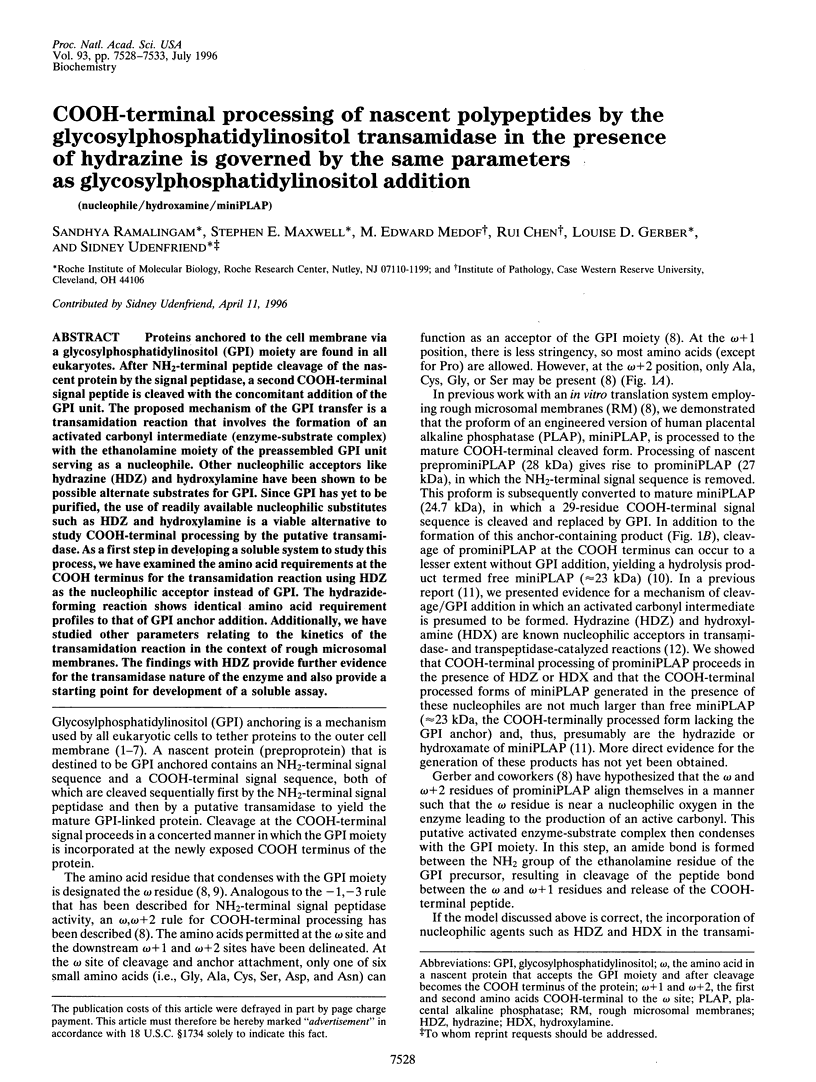
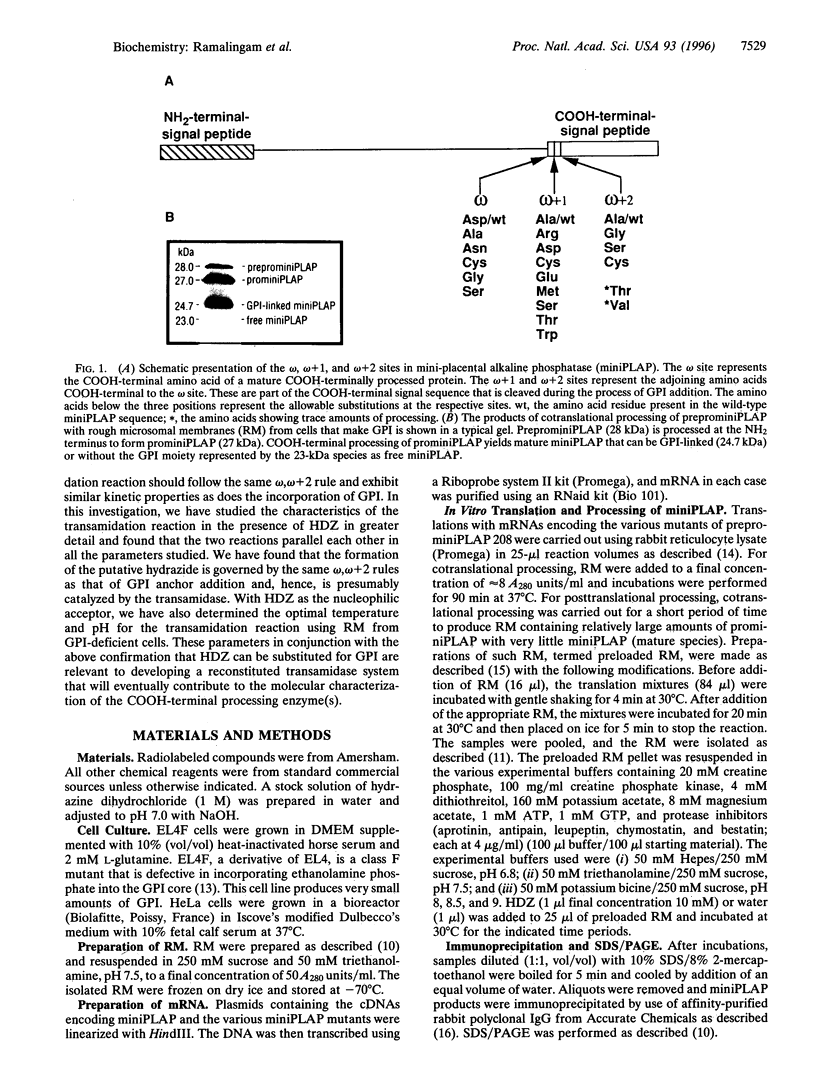
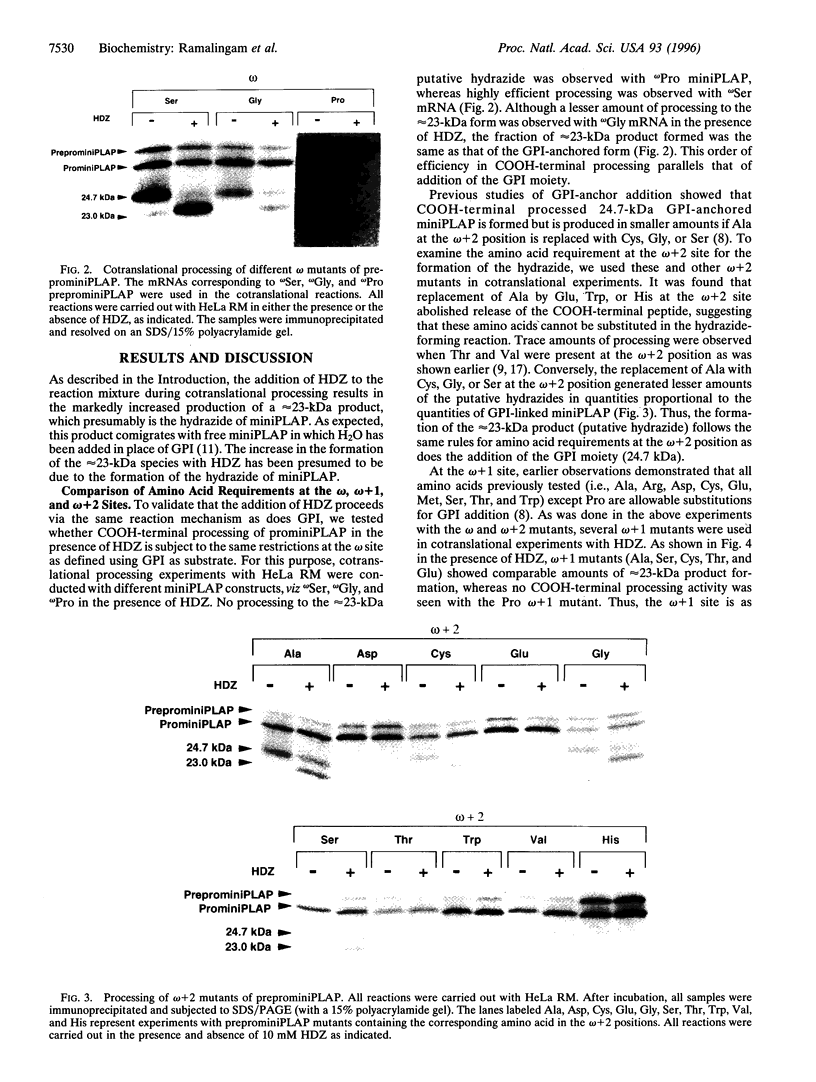
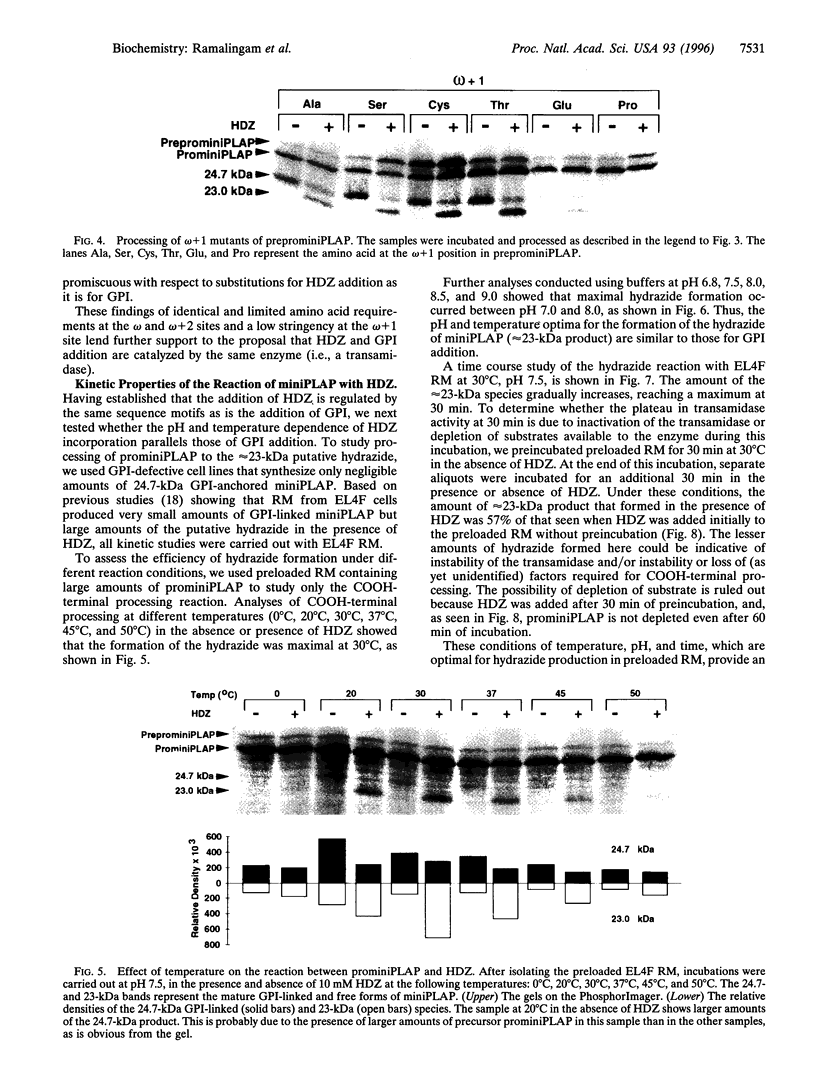
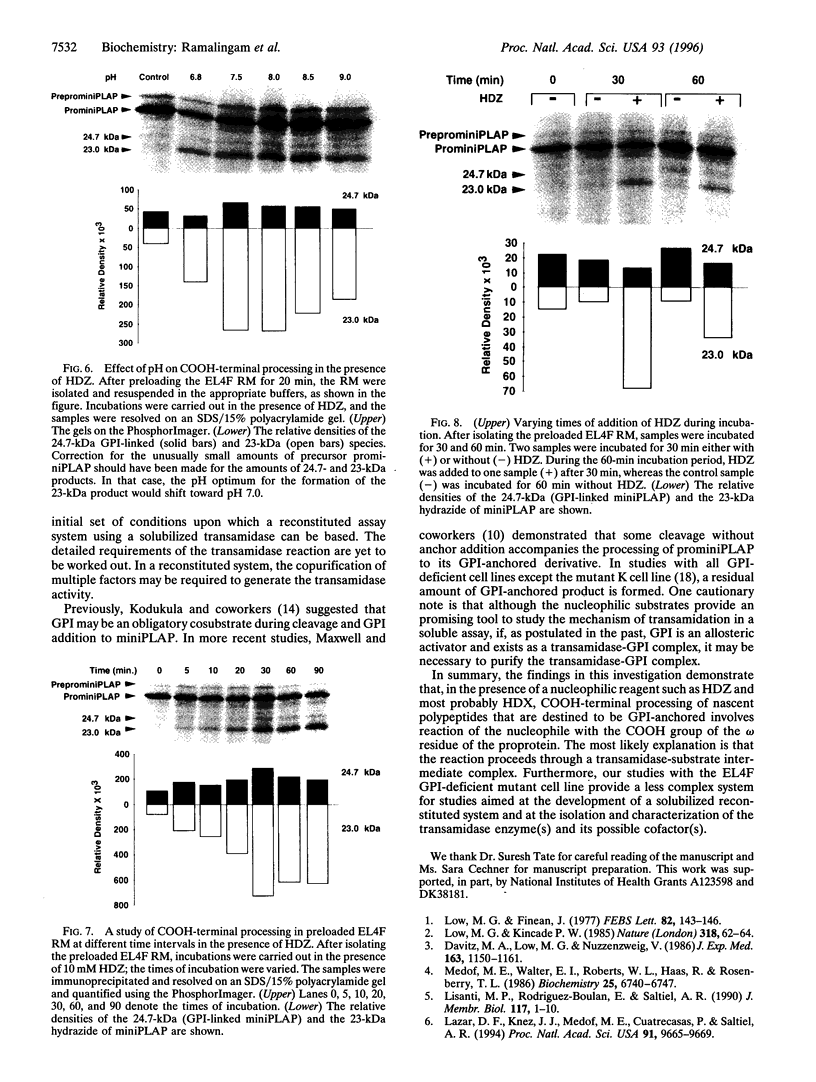

Images in this article
Selected References
These references are in PubMed. This may not be the complete list of references from this article.
- Amthauer R., Kodukula K., Brink L., Udenfriend S. Phosphatidylinositol-glycan (PI-G)-anchored membrane proteins: requirement of ATP and GTP for translation-independent COOH-terminal processing. Proc Natl Acad Sci U S A. 1992 Jul 1;89(13):6124–6128. doi: 10.1073/pnas.89.13.6124. [DOI] [PMC free article] [PubMed] [Google Scholar]
- Bailey C. A., Gerber L., Howard A. D., Udenfriend S. Processing at the carboxyl terminus of nascent placental alkaline phosphatase in a cell-free system: evidence for specific cleavage of a signal peptide. Proc Natl Acad Sci U S A. 1989 Jan;86(1):22–26. doi: 10.1073/pnas.86.1.22. [DOI] [PMC free article] [PubMed] [Google Scholar]
- Chen R., Udenfriend S., Prince G. M., Maxwell S. E., Ramalingam S., Gerber L. D., Knez J., Medof M. E. A defect in glycosylphosphatidylinositol (GPI) transamidase activity in mutant K cells is responsible for their inability to display GPI surface proteins. Proc Natl Acad Sci U S A. 1996 Mar 19;93(6):2280–2284. doi: 10.1073/pnas.93.6.2280. [DOI] [PMC free article] [PubMed] [Google Scholar]
- Davitz M. A., Low M. G., Nussenzweig V. Release of decay-accelerating factor (DAF) from the cell membrane by phosphatidylinositol-specific phospholipase C (PIPLC). Selective modification of a complement regulatory protein. J Exp Med. 1986 May 1;163(5):1150–1161. doi: 10.1084/jem.163.5.1150. [DOI] [PMC free article] [PubMed] [Google Scholar]
- Gerber L. D., Kodukula K., Udenfriend S. Phosphatidylinositol glycan (PI-G) anchored membrane proteins. Amino acid requirements adjacent to the site of cleavage and PI-G attachment in the COOH-terminal signal peptide. J Biol Chem. 1992 Jun 15;267(17):12168–12173. [PubMed] [Google Scholar]
- Hirose S., Prince G. M., Sevlever D., Ravi L., Rosenberry T. L., Ueda E., Medof M. E. Characterization of putative glycoinositol phospholipid anchor precursors in mammalian cells. Localization of phosphoethanolamine. J Biol Chem. 1992 Aug 25;267(24):16968–16974. [PubMed] [Google Scholar]
- Kodukula K., Cines D., Amthauer R., Gerber L., Udenfriend S. Biosynthesis of phosphatidylinositol-glycan (PI-G)-anchored membrane proteins in cell-free systems: cleavage of the nascent protein and addition of the PI-G moiety depend on the size of the COOH-terminal signal peptide. Proc Natl Acad Sci U S A. 1992 Feb 15;89(4):1350–1353. doi: 10.1073/pnas.89.4.1350. [DOI] [PMC free article] [PubMed] [Google Scholar]
- Kodukula K., Gerber L. D., Amthauer R., Brink L., Udenfriend S. Biosynthesis of glycosylphosphatidylinositol (GPI)-anchored membrane proteins in intact cells: specific amino acid requirements adjacent to the site of cleavage and GPI attachment. J Cell Biol. 1993 Feb;120(3):657–664. doi: 10.1083/jcb.120.3.657. [DOI] [PMC free article] [PubMed] [Google Scholar]
- Lazar D. F., Knez J. J., Medof M. E., Cuatrecasas P., Saltiel A. R. Stimulation of glycogen synthesis by insulin in human erythroleukemia cells requires the synthesis of glycosyl-phosphatidylinositol. Proc Natl Acad Sci U S A. 1994 Oct 11;91(21):9665–9669. doi: 10.1073/pnas.91.21.9665. [DOI] [PMC free article] [PubMed] [Google Scholar]
- Lisanti M. P., Rodriguez-Boulan E., Saltiel A. R. Emerging functional roles for the glycosyl-phosphatidylinositol membrane protein anchor. J Membr Biol. 1990 Jul;117(1):1–10. doi: 10.1007/BF01871561. [DOI] [PubMed] [Google Scholar]
- Lisanti M. P., Scherer P. E., Vidugiriene J., Tang Z., Hermanowski-Vosatka A., Tu Y. H., Cook R. F., Sargiacomo M. Characterization of caveolin-rich membrane domains isolated from an endothelial-rich source: implications for human disease. J Cell Biol. 1994 Jul;126(1):111–126. doi: 10.1083/jcb.126.1.111. [DOI] [PMC free article] [PubMed] [Google Scholar]
- Low M. G., Finean J. B. Non-lytic release of acetylcholinesterase from erythrocytes by a phosphatidylinositol-specific phospholipase C. FEBS Lett. 1977 Oct 1;82(1):143–146. doi: 10.1016/0014-5793(77)80905-8. [DOI] [PubMed] [Google Scholar]
- Low M. G., Kincade P. W. Phosphatidylinositol is the membrane-anchoring domain of the Thy-1 glycoprotein. Nature. 1985 Nov 7;318(6041):62–64. doi: 10.1038/318062a0. [DOI] [PubMed] [Google Scholar]
- Maxwell S. E., Ramalingam S., Gerber L. D., Brink L., Udenfriend S. An active carbonyl formed during glycosylphosphatidylinositol addition to a protein is evidence of catalysis by a transamidase. J Biol Chem. 1995 Aug 18;270(33):19576–19582. doi: 10.1074/jbc.270.33.19576. [DOI] [PubMed] [Google Scholar]
- Maxwell S. E., Ramalingam S., Gerber L. D., Udenfriend S. Cleavage without anchor addition accompanies the processing of a nascent protein to its glycosylphosphatidylinositol-anchored form. Proc Natl Acad Sci U S A. 1995 Feb 28;92(5):1550–1554. doi: 10.1073/pnas.92.5.1550. [DOI] [PMC free article] [PubMed] [Google Scholar]
- Medof M. E., Walter E. I., Roberts W. L., Haas R., Rosenberry T. L. Decay accelerating factor of complement is anchored to cells by a C-terminal glycolipid. Biochemistry. 1986 Nov 4;25(22):6740–6747. doi: 10.1021/bi00370a003. [DOI] [PubMed] [Google Scholar]
- Moran P., Raab H., Kohr W. J., Caras I. W. Glycophospholipid membrane anchor attachment. Molecular analysis of the cleavage/attachment site. J Biol Chem. 1991 Jan 15;266(2):1250–1257. [PubMed] [Google Scholar]
- Tate S. S., Meister A. Stimulation of the hydrolytic activity and decrease of the transpeptidase activity of gamma-glutamyl transpeptidase by maleate; identity of a rat kidney maleate-stimulated glutaminase and gamma-glutamyl transpeptidase. Proc Natl Acad Sci U S A. 1974 Sep;71(9):3329–3333. doi: 10.1073/pnas.71.9.3329. [DOI] [PMC free article] [PubMed] [Google Scholar]










